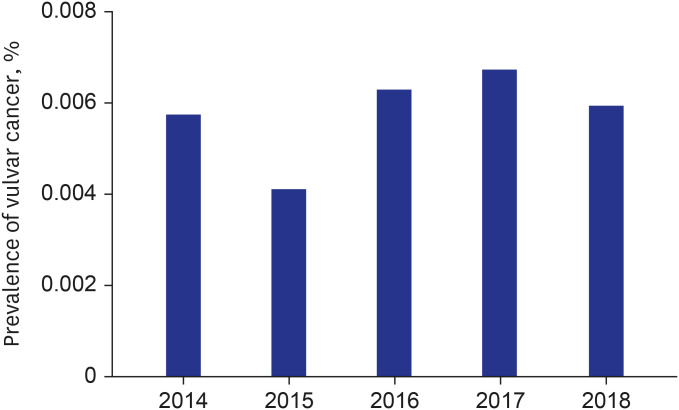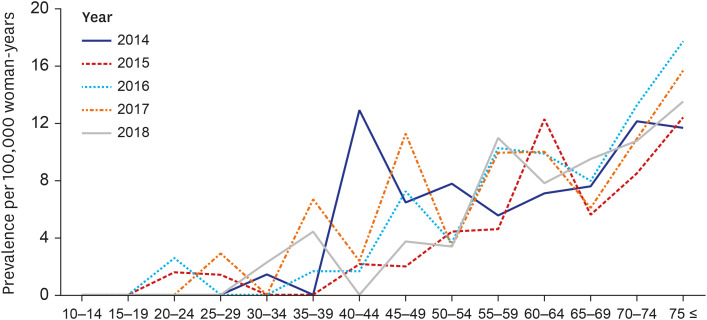J Korean Med Sci.
2022 Jan;37(4):e25. 10.3346/jkms.2022.37.e25.
Prevalence and Treatment of Vulvar Cancer From 2014−2018: A Nationwide Population-Based Study in Korea
- Affiliations
-
- 1Department of Obstetrics and Gynecology, School of Medicine, Kangwon National University, Chuncheon, Korea
- 2Data Science Team, Hanmi Pharmaceutical Co., Ltd., Seoul, Korea
- 3Department of Obstetrics and Gynecology, Korea University Guro Hospital, College of Medicine, Seoul, Korea
- KMID: 2525006
- DOI: http://doi.org/10.3346/jkms.2022.37.e25
Abstract
- Background
Vulvar cancer is one of the rare gynecologic malignancies. Despite the recent increasing trend of vulvar cancer in western countries due to the increased infection of human papillomavirus, there has been no study for population-based incidence of vulvar cancer in Korea. We aimed to investigate the prevalence and treatment of vulvar cancer in South Korea between 2014 and 2018.
Methods
Data from patients diagnosed and treated with vulvar cancer between 2014 and 2018 were obtained from the Health Insurance Review and Assessment Service/National Inpatient Sample (National In-Patient Sample) in South Korea.
Results
A total of 4,636,542 women were identified through the HIRA-NIS database from 2014 to 2018, of which 259 patients were diagnosed and treated for vulvar cancer. The mean age diagnosed with vulvar cancer was 62.82 (± 14.30) years in 2014, 64.19 (± 16.79) years in 2015, and 67.40 (± 14.41) years in 2016. In terms of treatment modalities, the most frequent treatment was surgery only without chemotherapy or radiation therapy. In the age-specific prevalence analysis, vulvar cancer was the most prevalent among those over 70 years old. According to multiple regression analysis, patients’ age was significantly associated with the prevalence of vulvar cancer. Vulvar cancer was more prevalent in women with low socioeconomic status (SES) compared to those with high SES in 2018 (OR, 4.242; P < 0.001).
Conclusion
Considering the high prevalence of vulvar cancer in the elderly, it is necessary to establish a new strategy for early screening and treatment.
Keyword
Figure
Reference
-
1. Judson PL, Habermann EB, Baxter NN, Durham SB, Virnig BA. Trends in the incidence of invasive and in situ vulvar carcinoma. Obstet Gynecol. 2006; 107(5):1018–1022. PMID: 16648405.
Article2. Bodelon C, Madeleine MM, Voigt LF, Weiss NS. Is the incidence of invasive vulvar cancer increasing in the United States? Cancer Causes Control. 2009; 20(9):1779–1782. PMID: 19680749.
Article3. Tanaka Y, Ueda Y, Kakuda M, Yagi A, Okazawa A, Egawa-Takata T, et al. Trends in incidence and long-term survival of Japanese women with vulvar cancer: a population-based analysis. Int J Clin Oncol. 2019; 24(9):1137–1142. PMID: 31025128.
Article4. Akhtar-Danesh N, Elit L, Lytwyn A. Trends in incidence and survival of women with invasive vulvar cancer in the United States and Canada: a population-based study. Gynecol Oncol. 2014; 134(2):314–318. PMID: 24875124.
Article5. Lai J, Elleray R, Nordin A, Hirschowitz L, Rous B, Gildea C, et al. Vulval cancer incidence, mortality and survival in England: age-related trends. BJOG. 2014; 121(6):728–738. PMID: 24148762.
Article6. Watson M, Saraiya M, Wu X. Update of HPV-associated female genital cancers in the United States, 1999–2004. J Womens Health (Larchmt). 2009; 18(11):1731–1738. PMID: 19951205.
Article7. Forman D, de Martel C, Lacey CJ, Soerjomataram I, Lortet-Tieulent J, Bruni L, et al. Global burden of human papillomavirus and related diseases. Vaccine. 2012; 30(Suppl 5):F12–F23. PMID: 23199955.
Article8. Pils S, Gensthaler L, Alemany L, Horvat R, de Sanjosé S, Joura EA. HPV prevalence in vulvar cancer in Austria. Wien Klin Wochenschr. 2017; 129(21-22):805–809. PMID: 28884278.
Article9. Wakeham K, Kavanagh K, Cuschieri K, Millan D, Pollock KG, Bell S, et al. HPV status and favourable outcome in vulvar squamous cancer. Int J Cancer. 2017; 140(5):1134–1146. PMID: 27864932.
Article10. Chaturvedi AK, Engels EA, Anderson WF, Gillison ML. Incidence trends for human papillomavirus-related and -unrelated oral squamous cell carcinomas in the United States. J Clin Oncol. 2008; 26(4):612–619. PMID: 18235120.
Article11. Senkomago V, Henley SJ, Thomas CC, Mix JM, Markowitz LE, Saraiya M. Human Papillomavirus-Attributable Cancers - United States, 2012-2016. MMWR Morb Mortal Wkly Rep. 2019; 68(33):724–728. PMID: 31437140.
Article12. Kwon SH, Cho CH, Kwon SH, Rhee JH, Kim JI, Lee TS, et al. The changing Trends of the Incidence and Histopathology of the Female Genital Malignancies in Keimyung University Dongsan Medical Center Between 1975 and 2000. Korean J Obstet Gynecol. 2002; 45(5):806–810.13. Iversen T, Tretli S. Intraepithelial and invasive squamous cell neoplasia of the vulva: trends in incidence, recurrence, and survival rate in Norway. Obstet Gynecol. 1998; 91(6):969–972. PMID: 9611006.
Article14. Baandrup L, Varbo A, Munk C, Johansen C, Frisch M, Kjaer SK. In situ and invasive squamous cell carcinoma of the vulva in Denmark 1978–2007-a nationwide population-based study. Gynecol Oncol. 2011; 122(1):45–49. PMID: 21474166.
Article15. Schuurman MS, van den Einden LC, Massuger LF, Kiemeney LA, van der Aa MA, de Hullu JA. Trends in incidence and survival of Dutch women with vulvar squamous cell carcinoma. Eur J Cancer. 2013; 49(18):3872–3880. PMID: 24011936.
Article16. Han CH, Cho HJ, Lee SJ, Bae JH, Bae SN, Namkoong SE, et al. The increasing frequency of cervical cancer in Korean women under 35. Cancer Res Treat. 2008; 40(1):1–5. PMID: 19688057.
Article17. Seong J, Ryou S; S SJ. Overview of the efficacy of human papillomavirus virus vaccines. J Bacteriol Virol. 2020; 50(3):158–167.
Article18. Kim MA, Han GH, Kim JH, Seo K. Current status of human papillomavirus infection and introduction of vaccination to the national immunization program in Korea: an overview. J Korean Med Sci. 2018; 33(52):e331. PMID: 30584412.
Article19. Guerrero D, Guarch R, Ojer A, Casas JM, Méndez-Meca C, Esteller M, et al. Differential hypermethylation of genes in vulvar cancer and lichen sclerosus coexisting or not with vulvar cancer. Int J Cancer. 2011; 128(12):2853–2864. PMID: 20734389.
Article20. Kim Y, Kim JY, Kim JY, Lee NK, Kim JH, Kim YB, et al. Treatment outcomes of curative radiotherapy in patients with vulvar cancer: results of the retrospective KROG 1203 study. Radiat Oncol J. 2015; 33(3):198–206. PMID: 26484303.
Article21. Stroup AM, Harlan LC, Trimble EL. Demographic, clinical, and treatment trends among women diagnosed with vulvar cancer in the United States. Gynecol Oncol. 2008; 108(3):577–583. PMID: 18155274.
Article22. Rakislova N, Alemany L, Clavero O, Del Pino M, Saco A, Quirós B, et al. Differentiated vulvar intraepithelial neoplasia-like and lichen sclerosus-like lesions in HPV-associated squamous cell carcinomas of the vulva. Am J Surg Pathol. 2018; 42(6):828–835. PMID: 29505429.
Article23. van de Nieuwenhof HP, Bulten J, Hollema H, Dommerholt RG, Massuger LF, van der Zee AG, et al. Differentiated vulvar intraepithelial neoplasia is often found in lesions, previously diagnosed as lichen sclerosus, which have progressed to vulvar squamous cell carcinoma. Mod Pathol. 2011; 24(2):297–305. PMID: 21057461.
Article24. Ki M, Choi HY, Han M, Oh JK. The economic burden of human papillomavirus infection-associated diseases in the Republic of Korea, 2002-2015. Vaccine. 2018; 36(31):4633–4640. PMID: 29961603.
Article25. Kim YT, Serrano B, Lee JK, Lee H, Lee SW, Freeman C, et al. Burden of Human papillomavirus (HPV)-related disease and potential impact of HPV vaccines in the Republic of Korea. Papillomavirus Res. 2019; 7:26–42. PMID: 30599280.
Article26. Stenhammar C, Ehrsson YT, Åkerud H, Larsson M, Tydén T. Sexual and contraceptive behavior among female university students in Sweden - repeated surveys over a 25-year period. Acta Obstet Gynecol Scand. 2015; 94(3):253–259. PMID: 25619646.
Article27. Oh JK, Choi HY, Han M, Lee JK, Min KJ, Ki M. Prevalence of human papillomavirus-related diseases in the Republic of Korea: a cross-sectional study. Sex Transm Infect. 2019; 95(4):292–299. PMID: 30679392.
Article28. Blomberg M, Dehlendorff C, Kjaer SK. Risk of CIN2+ following a diagnosis of genital warts: a nationwide cohort study. Sex Transm Infect. 2019; 95(8):614–618. PMID: 31092605.
Article29. Rotsides JM, Oliver JR, Moses LE, Tam M, Li Z, Schreiber D, et al. Socioeconomic and racial disparities and survival of human papillomavirus-associated oropharyngeal squamous cell carcinoma. Otolaryngol Head Neck Surg. 2021; 164(1):131–138. PMID: 32660368.
Article30. Benard VB, Johnson CJ, Thompson TD, Roland KB, Lai SM, Cokkinides V, et al. Examining the association between socioeconomic status and potential human papillomavirus-associated cancers. Cancer. 2008; 113(10):Suppl. 2910–2918. PMID: 18980274.
Article31. Celie KB, Jackson C, Agrawal S, Dodhia C, Guzman C, Kaufman T, et al. Socioeconomic and gender disparities in anal cancer diagnosis and treatment. Surg Oncol. 2017; 26(2):212–217. PMID: 28577728.
Article32. McCarthy AM, Dumanovsky T, Visvanathan K, Kahn AR, Schymura MJ. Racial/ethnic and socioeconomic disparities in mortality among women diagnosed with cervical cancer in New York City, 1995–2006. Cancer Causes Control. 2010; 21(10):1645–1655. PMID: 20521091.
Article33. Rottmann M, Beck T, Burges A, Dannecker C, Kiechle M, Mayr D, et al. Trends in surgery and outcomes of squamous cell vulvar cancer patients over a 16-year period (1998–2013): a population-based analysis. J Cancer Res Clin Oncol. 2016; 142(6):1331–1341. PMID: 26973058.
Article34. Günther V, Malchow B, Schubert M, Andresen L, Jochens A, Jonat W, et al. Impact of radical operative treatment on the quality of life in women with vulvar cancer--a retrospective study. Eur J Surg Oncol. 2014; 40(7):875–882. PMID: 24746935.35. Lee J, Kim SH, Kim G, Yu M, Park DC, Yoon JH, et al. Treatment outcome in patients with vulvar cancer: comparison of concurrent radiotherapy to postoperative radiotherapy. Radiat Oncol J. 2012; 30(1):20–26. PMID: 23120740.
Article36. Martinez-Castro P, Poveda A, Guinot JL, Minig L. Treatment of inoperable vulvar cancer: where we come from and where are we going. Int J Gynecol Cancer. 2016; 26(9):1694–1698. PMID: 27575631.
Article37. Seong SJ, Lim KT, Chung HW, Lee KH, Park IS, Shim JU, et al. Primary invasive carcinoma of the vulva: a clinical review. Korean J Obstet Gynecol. 2002; 45(5):800–805.
- Full Text Links
- Actions
-
Cited
- CITED
-
- Close
- Share
- Similar articles
-
- The prognostic significance of primary tumor site in vulvar cancer: a population-based cohort study
- Vulvar chondrosarcoma: A case report
- Pregnancy following vulvar squamous cell carcinoma: a report of two cases
- Cancer Statistics in Korea: Incidence, Mortality, Survival, and Prevalence in 2014
- Ultrasonography of benign vulvar lesions



